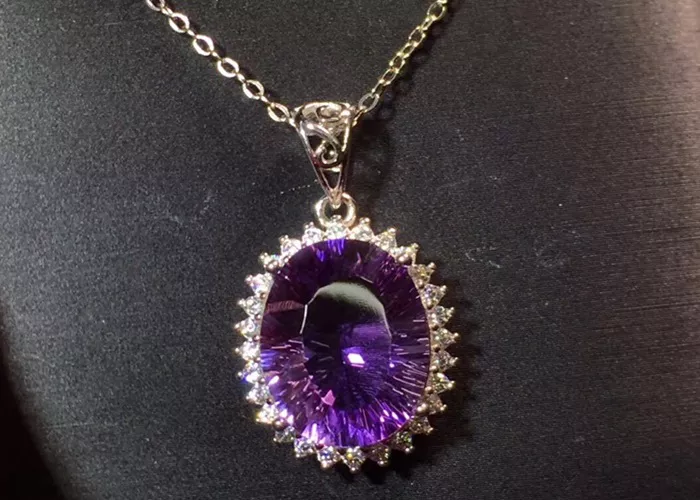Amethyst is one of the most popular gemstones in the jewelry world. Known for its vibrant purple hue and its spiritual significance, this beautiful crystal has been a sought-after stone for centuries. Whether you’re a jewelry designer, collector, or simply someone fascinated by gemstones, understanding where amethyst is found adds depth to its allure. This article will explore the primary sources of amethyst crystals, their geological background, and the qualities that make them so desirable in the jewelry industry.
What is Amethyst?
Amethyst is a variety of quartz that ranges in color from light lavender to deep purple. Its captivating shades are caused by the presence of iron and aluminum within the crystal structure. Over time, amethyst has gained popularity not only for its beauty but also for its spiritual and healing properties. Often used in rings, necklaces, and earrings, amethyst adds an elegant touch to any jewelry collection. But beyond its aesthetic appeal, it’s essential to understand where this crystal is sourced.
Geological Origins of Amethyst
The formation of amethyst is primarily linked to volcanic activity. This crystal forms in geodes, which are hollow rock formations, often in volcanic areas. Over millions of years, mineral-rich water flows into these cavities, creating the unique conditions needed for amethyst to grow. The minerals, such as iron, react with the quartz, giving the amethyst its signature purple color.
Amethyst Locations Worldwide
Amethyst can be found in numerous locations across the globe. The most notable sources include:
Brazil
Brazil is one of the largest producers of amethyst crystals in the world. The state of Rio Grande do Sul, known for its large geodes, is a significant source of high-quality amethyst. The deep purple amethyst from Brazil is highly prized in the jewelry industry due to its rich color and clarity.
Zambia
Zambia is another important location for amethyst mining. The country is known for producing large quantities of high-quality amethyst, often with a vibrant violet color. Zambian amethyst has gained recognition for its deep hues and excellent transparency, making it a favorite among jewelers worldwide.
Uruguay
Uruguay is also a significant producer of amethyst. The amethyst found here is renowned for its rich purple tones and remarkable clarity. The amethyst geodes from Uruguay are often prized for their size and are sometimes used in raw, uncut forms for display pieces.
Other Countries Producing Amethyst
Amethyst is also found in various other countries, including:
- United States (notably in Arizona and North Carolina)
- Mexico
- South Korea
- India
- Canada
Each of these regions produces amethyst with unique qualities, including variations in color and size, which contribute to the diversity in the gemstone market.
Amethyst Meaning and Significance
Beyond its geological origins, amethyst holds a significant place in various cultures and spiritual practices. Known as the “stone of sobriety,” it was historically believed to prevent intoxication and promote clear thinking. The amethyst meaning in many cultures symbolizes peace, calmness, and balance. Its calming energy is thought to aid in meditation and spiritual growth.
Amethyst Properties
Amethyst’s physical properties contribute to its wide appeal. As a variety of quartz, it is relatively hard, registering a 7 on the Mohs scale of hardness. This durability makes it an excellent choice for everyday jewelry. Additionally, amethyst is prized for its vibrant color, which ranges from pale lavender to deep violet, often with flashes of red or blue.
Another unique feature of amethyst is its ability to change color when exposed to different light sources. Under incandescent light, it can appear darker, while fluorescent light often reveals more vivid purple tones. This natural play of color adds to the gem’s visual interest and makes it a versatile gemstone for various jewelry pieces.
Amethyst Benefits in the Jewelry Industry
Amethyst’s popularity in the jewelry industry is partly due to its versatility and aesthetic appeal. As one of the most affordable gemstones in the market, amethyst is a top choice for both high-end jewelry and more budget-friendly designs. Its availability in various shades and sizes allows designers to create a wide range of pieces, from simple earrings to elaborate necklaces.
Moreover, the amethyst benefits extend beyond aesthetics. Many people believe that amethyst has healing properties that promote emotional well-being and mental clarity. This belief has contributed to the stone’s enduring popularity, as individuals seek to incorporate the crystal’s positive energy into their daily lives.
Amethyst and Jewelry Design
As a jewelry designer, amethyst offers endless possibilities for creative expression. Its striking color makes it a statement piece in both modern and traditional designs. Whether used as the centerpiece of an engagement ring or as an accent stone in a bracelet, amethyst can be styled to suit any taste. Its affordability also allows designers to experiment with larger stones or multiple pieces, such as in a set of matching earrings, necklace, and bracelet.
Additionally, amethyst pairs well with various metals, including gold, silver, and platinum. Its rich purple hue contrasts beautifully with both yellow and white metals, creating timeless designs. Amethyst also complements other gemstones, making it an ideal choice for multi-stone pieces.
Conclusion
Amethyst is a gemstone that is not only beautiful but also rich in history and meaning. From its geological origins in volcanic regions to its diverse locations around the world, amethyst remains a prized crystal in the jewelry industry. Whether you’re drawn to its stunning colors or its metaphysical properties, amethyst continues to be a favorite among collectors and jewelers alike. With its variety of sources, each with its unique qualities, amethyst will undoubtedly remain a beloved gemstone for generations to come.
If you’re interested in learning more about amethyst properties, its meaning, and the benefits of incorporating it into your jewelry designs, there’s a wealth of information available to explore.
Related topic:
- How to Cleanse Pink Amethyst and Maintain Its Energy?
- How Much Is Pink Amethyst Worth?
- Which Regions’ Antique Markets Are Famous for Amethyst Necklaces?


